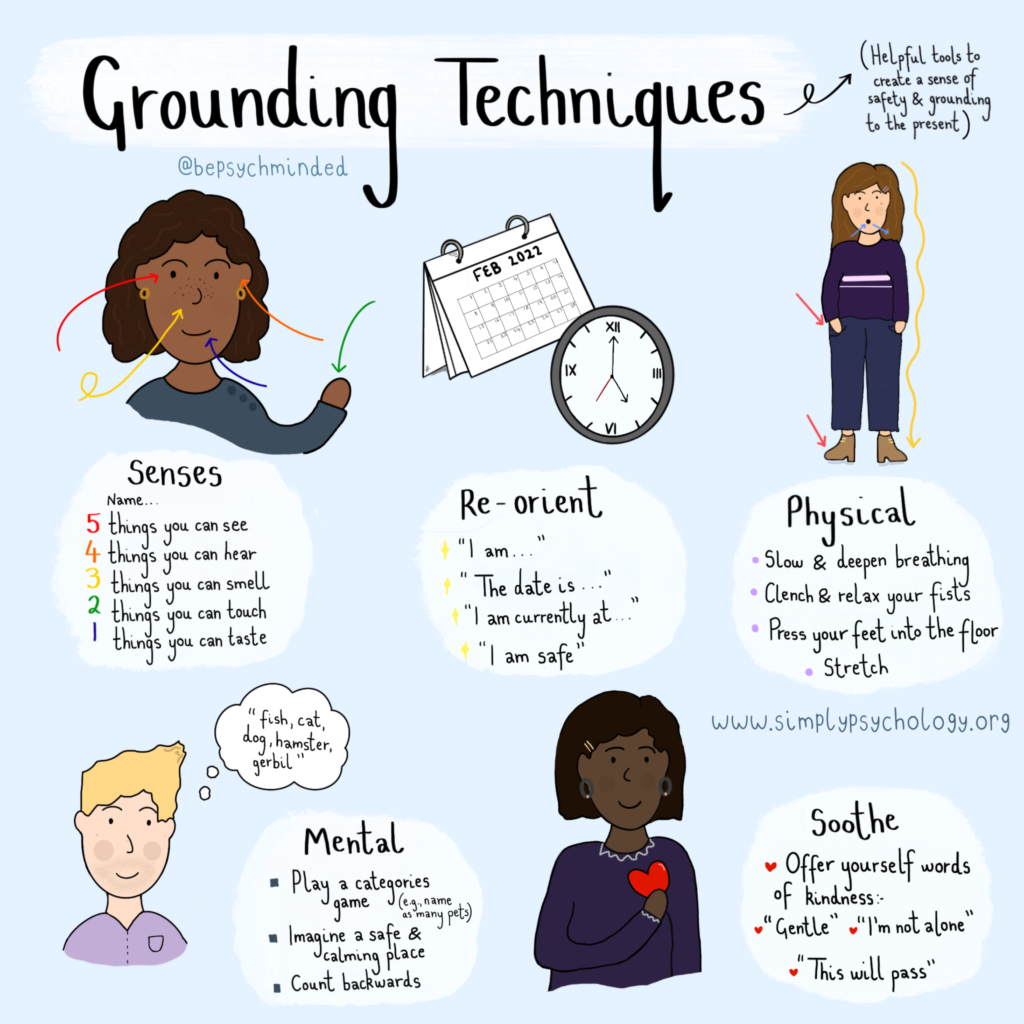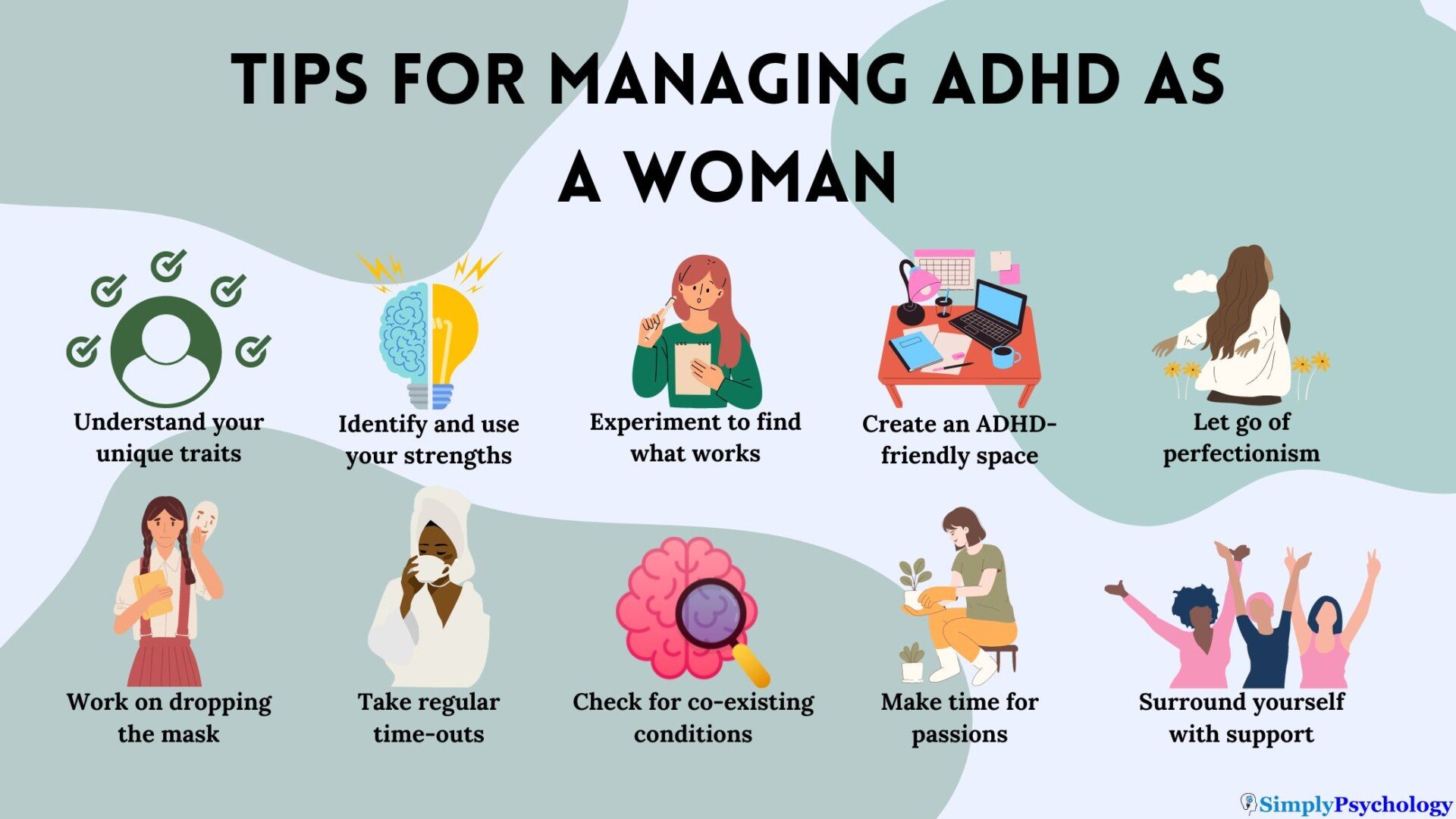While ADHD does not only affect a specific gender, societal expectations and traditional diagnostic criteria have historically skewed towards recognizing symptoms more prevalent in boys. Consequently, many girls with ADHD find themselves overlooked or diagnosed later in life.
ADHD manifests differently in women, with symptoms often centered around inattentiveness rather than hyperactivity (Quinn & Madhoo, 2014).

Because of this, women’s presentation of ADHD can often be missed as they are considered “sub-threshold” with inattentiveness overshadowing typical displays of ADHD, such as being unable to sit still and being verbally impulsive.
This can lead to developing compensating strategies, which can further mask symptoms over time.
Consequently, adverse outcomes in academic, work, and personal life can begin to arise just as they would with men.
Therefore, ADHD does not confine itself to specific settings; it permeates all aspects of a woman’s life, with the challenges posed being far-reaching and pervasive. It is, therefore, important to have management strategies to live a fulfilling life with ADHD.
Below we discuss some tips for managing ADHD as a woman:
1. Understand ADHD and how it uniquely affects you
Understanding the nuances of ADHD is essential to recognizing your unique presentations and recognizing how ADHD manifests in your life.
For example, realizing how your forgetfulness, emotional dysregulation, and disorganization manifest and shape your experiences can help you gain a clearer picture of ways to manage your ADHD symptoms.
There are unique presentations associated with being a woman with ADHD in comparison to both neurotypical women and men with ADHD.
For instance, you may notice that you need to take extra steps to make sure you do not forget deadlines or that you tend to get emotionally triggered a lot easier than your friends.
Becoming aware of your ADHD signs and figuring out which ones are impacting you can be the first step in managing your ADHD better as a woman.
2. Identify your strengths
Identifying and leveraging your strengths is pivotal for building self-confidence and navigating challenges associated with ADHD.
Dedicated research has also been conducted on ADHD’s strengths, with several uncovered, such as divergent thinking and adventurousness (Sedgwick, Merwood, Asherson, 2019).
For example, a woman with ADHD might identify her strengths in multitasking and creative thinking, which contribute positively to her role as a team member in the workplace.
Dr Michele Novotni encourages people to lean into their strengths and work on them daily. Specifically, she suggests:
“Each day, intentionally set out to build or improve a relationship at work through an area of your strength. If you are kind, find a situation to demonstrate your kindness. If you are funny, brighten someone’s day. Look for an opportunity to shine each day.”
A good idea if you would like to do this by yourself is to keep a journal of your achievements and successes throughout the day.
Write down specific instances where you demonstrated your strengths. This can serve as a helpful reference for acknowledging your capabilities and start building a list.
You can also discuss strengths with trusted loved ones, e.g., friends, spouse, or family members. Sometimes, it can be hard to identify our own strengths, so asking someone for their perspective on this may then lead to further insights.
Try asking them questions such as “What do you think I excel at?” or “What qualities do you most appreciate about me?”
Dr. Tony Lloyd, C.E.O. for the ADHD Foundation Neurodiversity Charity, states that:
“ADHD can present challenges in our daily lives, but many individuals testify to strengths and positives associated with this condition once we understand it and learn how to manage it. ADHD does not define you, it is a lens through which you experience the world we live in.”
3. Experiment to find what works well for you
Women with ADHD often benefit from a personalized approach to managing symptoms.
For example, consider a woman with ADHD who struggles to maintain focus during group conversations. In her experimentation phase, she discovers effective strategies like active listening techniques, using a fidget tool, and using open-ended questions to get back into conversation.
By incorporating these methods, she enhances her ability to stay engaged and follow discussions more effectively in social settings.
Using focus difficulties as the main challenge, here are some steps you can take to find what works for you:
- Identify 2-3 priority areas where struggling to focus impacts your daily functioning.
- Begin experimenting with small adjustments, e.g., using tools such as task reminder systems, sensory aids, color-coded systems, pomodoro technique, etc.
- Keep a journal or use tracking apps to monitor the impact of different strategies on your ability to focus.
- Exercise patience and compassion towards yourself. If a particular method doesn’t work, consider it a learning experience and adjust accordingly.
One woman with ADHD explains a method that works for her to get things done around the home:
“I put on shoes when I need to do things or keep them on if I have to do things when I get home. For some reason, my brain is like shoes off = time to check out.”
‘Naomi’
Another woman explains how she makes sure she doesn’t miss appointments:
“I set alarms for appointments, so I don’t sit and spend the whole day waiting for the appointment for fear of losing track of time. I set alarms for so many things, but that particular type of alarm has been a game-changer for me. And when I put an appointment in my phone’s calendar that’s more than a week out, I set a reminder for a day or two before the appointment to make sure I don’t forget it exists.”
‘Kalynn’
Learn from mistakes
Lastly, always remember that mistakes are not failures but opportunities for learning and growth. Therefore, even though some things you try may not work for you, by adopting a growth mindset, you can begin viewing challenges as chances to acquire new knowledge and enhance your skills.
Try to avoid ruminating on self-criticism, and remember that everyone has such moments, and it is all part of being human.
Reflect on your experience, adjust your strategies, and move forward with greater wisdom. By approaching life’s hurdles with this mindset, you can reinforce a constructive self-image based on resilience and continuous improvement.
4. Create an ADHD-friendly environment
Adapting your surroundings to accommodate ADHD challenges can significantly improve daily functioning and productivity.
Here are a few suggestions to get started:
- Ensure you minimize any distractions. This can be from the environment, e.g., noise and bright lights, or electronic, e.g., app notifications and messages.
- Remove any temptations when working. Whether that is looking at your phone, a website, or talking to a colleague, ensure you have nothing around you that may shift your focus.
- There are websites and apps available that lock you out of the specific website you chose, e.g., Instagram, for a set amount of time to increase productivity.
- Organize with intent and try implementing organizational systems that cater to your unique needs. This may include color-coding, labeling, or using visual cues.
- This can branch out into your decor choices as well. For example, you can opt for decor elements that promote a calming atmosphere, such as soothing colors and comfortable furniture.
- Declutter your space frequently. Ensure that your environment is helping you be organized and focused without any unnecessary items littered in the space.
- Lastly, design your space with flexibility in mind, allowing for different workstations or areas for various activities. This can create a modular space that can be changed depending on your needs and your mood.
“Design your home to fit your brain, not just your design aesthetic. I took the doors off most of my closets because the act of opening them was enough to make me not put stuff away, and having them closed meant I forgot where my stuff was. I put shoe racks right at the door I enter through, not some distant closet which would be tidier because I’m never gonna use it.”
‘Suzanne’
5. Let go of perfection
Perfectionism can be an issue for women because they may be expected to be good at many things at once, e.g., at work, home life, and motherhood.
These are a lot of responsibilities to handle, so maintaining the pressure to perform perfectly can have a negative impact on self-esteem.
Successes and rewards can also seem underserved if they are not up to the “perfect” standards set by you (Wang, Sheveleva & Permyakova, 2019). Therefore, tackling perfectionism head-on may help you manage day-to-day life better.
Practice Acceptance
Acceptance that there is no such thing as absolute perfection and that mistakes are a natural occurrence in life is an important first step.
If tendencies to compare begin to flare, which is highly probable that they might, remember that there are 2 sides to everything, and just as someone may be more skilled at something than you, you are also more skilled at certain things than others. Begin to be kinder and learn to forgive yourself.
‘Lena’ who has ADHD shares her advice:
“Don’t compare yourself to others or try to compete with your peers. You are on your own path. Celebrate the success of others, but remember that their goals are not your goals – only you know what those are.”
Reframe Thinking
Once negative thought patterns have been recognized and acknowledged, the next step is challenging and reframing them.
For example, consider a woman with ADHD who struggles with time management and often arrives late to social events.
The negative thought pattern might be, “I’m always letting people down; I can not even be on time like everyone else.”
This thought can be reframed more positively: “While punctuality is a challenge for me, I am working on improving my time management, and I appreciate the understanding and support of those around me. I bring enthusiasm to my interactions with people and offer unique perspectives”.
This will take time, and it may not happen right away, but consistency and slowly building up a more positive mindframe will get someone a long way.
It is also important to consider external factors, e.g., perceptions and comments from people around you.
For example, if you have the belief that you are not good enough but your close friends and colleagues always compliment your abilities, this is all evidence that perhaps you are doing better than you thought!
6. Consider dropping the mask
Masking in ADHD refers to the conscious or subconscious efforts of individuals to hide or suppress their symptoms in order to conform to social expectations or avoid negative judgments and stigmatization.
Masking is usually done in an attempt to overcompensate or camouflage one’s ADHD traits (Barkley, 2020).
For example, take a woman with ADHD who, when out with friends, has a tendency to remain silent or withdrawn out of worry or judgment over her ADHD symptoms, such as impulsiveness and cutting people mid-conversation.
Women with ADHD are far more likely to mask and for a variety of reasons, such as:
- Fitting in with peers
- Trying to meet societal expectations of women,
- Hiding work-related struggles
Common masking behaviors and how to drop the mask:
- If you blame forgetfulness on a lack of sleep, TRY Embracing forgetfulness as a human trait, prioritize sleep, and establish healthy routines.
- If you excessively take notes in class or do all-nighters to prepare for a test, TRY Using efficient study techniques over last-minute tactics.
- If you make a conscious effort to stop yourself from fidgeting, TRY Embracing fidgeting as a cognitive aid.
- If you hold back on speaking or sharing opinions in conversations, TRY Encouraging open communication while expressing your thoughts and opinions.
- If you pretend to be calm and put-together in social situations but then become upset and frustrated when alone, TRY Embracing authentic social engagement and allow yourself to express genuine emotions.
7. Schedule regular time-outs
Women with ADHD often benefit from scheduled breaks to recharge and manage sensory overload. For example, going out in heavily crowded places, such as a bar, can be overwhelming.
Heading outside occasionally or in the restroom can provide a necessary buffer and recharge.
Dr. Ari Tuckman, an expert in ADHD management, suggests using coping strategies like deep breathing and self-reflection to reduce impulsive reactions. You can read more of Dr. Tuckman’s work in his book “More Attention, Less Deficit: Success Strategies for Adults with ADHD” (Tuckman, 2009).
Here are a few suggestions on what to do:
Grounding
Include periodic “cool-down” or rest intervals in your day to allow yourself to unwind and prevent shutdowns. For example, you can step away from potentially stressful circumstances during these periods to regroup.
If you are in a situation where you can not remove yourself, you can switch to grounding exercises instead to try and keep yourself present in the moment. These can include things such as counting and visualization.

Self-soothing
Creating self-soothing techniques can also help you deal with overstimulation when it arises. These methods could involve mindfulness and deep breathing exercises (Bueno et al., 2015).
Such brief rest periods can act as a protective mechanism and keep sensory overload from both developing and escalating.
Finding a go-to technique for soothing yourself can then make it easier to restore control in stressful situations if you have a mechanism in place you know you can resort to when needed.
Each person is different in what works best for them, so try out various methods to see which one aligns with you the best.
Relaxation
Utilize relaxation techniques in your regular activities to control stress and avoid overstimulation. Some popular methods are yoga (Lange, 2014), meditation, and progressive muscle relaxation, which can help your sensory processing and aid in emotional response regulation.
You can begin on a weekly basis and increase the frequency to even daily if needed or desired. By employing such strategies, you will encourage serenity and possibly raise your general resistance to sensory overload.
“Making time to pursue your passions in self-care is restorative and affirming and will give you more time. It’s not that it’s going to take more time, which is often the myth. Even superwomen need recharging to own their true power. You owe it to yourself and to the world to put yourself first.”
Carol Ann Robbins, Licensed Clinical Psychologist
8. Identify any coexisting conditions
Coexisting conditions often accompany ADHD in women. Therefore, identifying and addressing these conditions is crucial for comprehensive care that ensures all your symptoms and needs are addressed.
For example, a woman with ADHD may struggle with social anxiety every time she has to go out and interact with people, e.g., social events or even work. If left unaddressed, this can cause a negative cycle of avoidance, potentially leading to isolation and symptom exacerbation.
Common Conditions in Women with ADHD
While this is not a definitive list, there are certain conditions that have a higher likelihood of coexisting in women with ADHD:
- Generalized Anxiety (Fischer et al., 2007)
- Social Anxiety (Edel et al., 2010)
- Depression (Quinn, 2008)
- PMDD or Premenstrual Dysphoric Disorder (Dorani, Bijlenga, Beekman, van Someren & Kooij, 2021)
How to try and identify additional signs of other conditions
As a woman getting your ADHD evaluation, it is important to highlight any long-term and pervasive feelings of anxiety, worry, low mood, or lack of joy in doing things. This can help the assessor formulate and investigate other common conditions, as mentioned above.
Additionally, inform yourself about other common diagnosis that share symptoms with ADHD:
For example, impulsivity. Other people on the neurodiverse spectrum can also experience it, like individuals on the autism spectrum (Hlavatá, Kašpárek, Linhartová, Ošlejšková & Bareš, 2018).
Some mental health conditions, such as bipolar (Najt, 2007) or borderline personality disorder (Berlin, Rolls & Iversen, 2005), can also show impulsive tendencies.
If you are experiencing struggles with mood, it might be worth looking into Intermittent Explosive Disorder or IED (Gnanavel, Sharma, Kaushal & Hussain, 2019) and alexithymia.
Lastly, if you suspect any such coexisting conditions, do not neglect them, but reach out to a medical/mental health professional to help guide you.
Why it is helpful to identify these conditions
It can be easy to group all presenting symptoms as being a byproduct of ADHD. However, this can lead to treatment and management strategies that are ineffective, causing further worsening of symptoms and a sense of helplessness for the person.
Therefore, by correctly identifying any underlying coexisting conditions, the correct strategies can be used to support you in your daily living and well-being.
Patricia Quinn, in her paper titled “Attention-deficit/hyperactivity disorder and its comorbidities in women and girls: An evolving picture” has shed light on the following findings:
“Girls with ADHD are 5.4 times more likely to be diagnosed with major depression and three times more likely to be treated for depression before their ADHD diagnosis.”
Quinn (2008)
9. Focus on the things you love
Prioritizing activities aligned with your passions can be a powerful strategy for women with ADHD.
Engaging in activities that bring joy not only enhances well-being but also serves as a valuable outlet for managing ADHD symptoms.
For example, a woman who has a passion for gardening. Amidst the challenges of her daily life, dedicating time to cultivate a garden becomes a therapeutic escape. The act of nurturing plants, witnessing their growth, and connecting with nature provides a sense of accomplishment and peace.
Here are a few tips on how to get started:
- Integrate your passion into your daily or weekly routine. This consistency not only ensures regular engagement but also provides a predictable and enjoyable aspect of your schedule.
- When engaging in your passion, practice mindfulness. Be fully present in the moment, allowing yourself to immerse in the activity without distraction.
- Be open to exploring new aspects of your passion. Trying new techniques, genres, or styles can keep the activity fresh and exciting.
10. Surround yourself with supportive people
Building a supportive network of friends, family, or colleagues who understand and respect ADHD is essential for emotional well-being. For example, using online communities that center around women with ADHD can be a great way to meet peers and make new friends.
Choosing to be in the company of individuals who offer support, encouragement, and understanding can do wonders for your self-esteem. Research indicates that even from a young age, social support is key in children with ADHD (Mastoras, Saklofske, Schwean & Climie, 2018)
Try sharing your ADHD-related challenges with friends and family who are nonjudgmental and empathetic as well, as it can provide a great sense of belonging by absolving yourself from all the pressures of masking and trying to hide symptoms.
Their support can significantly contribute to enhancing your self-esteem, as feeling understood and valued by others reinforces a positive self-concept (Manning, 2007).

FAQs:
How can a woman deal with a late diagnosis of ADHD?
Having a late diagnosis is unfortunately common for women with ADHD. Here are some strategies to help you deal with it:
- Educate Yourself: Learn as much as you can about ADHD, its symptoms, and how it manifests in adults. There is a plethora of information available, from professional accounts to personal stories
- Build a Support System: Connect with support groups, online communities, or friends who understand ADHD challenges
- Develop Coping Strategies: Work on strategies to manage ADHD symptoms, such as time management techniques, organizational tools, and mindfulness practices.
- Ask for Help: Consult with a mental health professional, preferably one with expertise in ADHD, for a comprehensive assessment and guidance. Reach out to trusted loved ones as well and ask for their support.
- Stay positive: Finally, having an ADHD diagnosis can feel like the world suddenly makes sense. This new understanding of yourself can bring a renewed sense of positivity and direction.
How can a woman with ADHD manage her work life?
Managing ADHD in the workplace as a woman can be challenging. Here are a few practical tips to help:
- Accommodations: Explore workplace accommodations to support your specific needs, e.g., flexible working
- Time Management Techniques: Use strategies like breaking tasks into smaller steps, setting realistic goals, and using timers to enhance focus
- Organizational Tools: Utilise things like calendars, planners, and task lists to stay organized. These can be either digital or just your regular pen and paper, whatever works best for your needs
- Identify your pique productive days: Doing work during your most energized times makes you more likely to finish tasks quicker and leave time for other activities
How can a woman with ADHD manage relationships with others?
If you are a woman with ADHD and you are struggling to manage your relationships, there are a few things that you can do to cope better in this area.
Firstly, reflect on yourself and your own actions. Are you communicating your needs and/or challenges? If so, are they coming across clearly and as intended? Try writing your thoughts down to consolidate them, or speak to a trusted loved one or therapist.
Secondly, help educate people around you about ADHD and what that means for you. Try sharing information, useful resources, or personal experiences.
Thirdly, when scheduling some quality time, instead of waiting for others to make suggestions, feel free to take the reins and organize something suitable for your needs.
Lastly, consider counseling or speaking to a professional to help express your views and get support on managing ADHD and the specific relationships in question.
References
Barkley, R. A. (2020). Taking charge of ADHD: The complete, authoritative guide for parents. Guilford Publications.
Berlin, H. A., Rolls, E. T., & Iversen, S. D. (2005). Borderline personality disorder, impulsivity, and the orbitofrontal cortex. American journal of psychiatry, 162(12), 2360-2373.
Bueno, V. F., Kozasa, E. H., da Silva, M. A., Alves, T. M., Louzã, M. R., & Pompéia, S. (2015). Mindfulness meditation improves mood, quality of life, and attention in adults with attention deficit hyperactivity disorder. BioMed Research International, 2015.
Dorani, F., Bijlenga, D., Beekman, A. T., van Someren, E. J., & Kooij, J. S. (2021). Prevalence of hormone-related mood disorder symptoms in women with ADHD. Journal of psychiatric research, 133, 10-15.
Edel, M. A., Rudel, A., Hubert, C., Scheele, D., Brüne, M., Juckel, G., & Assion, H. J. (2010). Alexithymia, emotion processing and social anxiety in adults with ADHD. European journal of medical research, 15, 403-409.
Fischer, A. G., Bau, C. H., Grevet, E. H., Salgado, C. A., Victor, M. M., Kalil, K. L., Sousa, N. O., Garcia, C. R. & Belmonte-de-Abreu, P. (2007). The role of comorbid major depressive disorder in the clinical presentation of adult ADHD. Journal of psychiatric research, 41(12), 991-996.
Gnanavel, S., Sharma, P., Kaushal, P., & Hussain, S. (2019). Attention deficit hyperactivity disorder and comorbidity: A review of literature. World journal of clinical cases, 7(17), 2420.
Hlavatá, P., Kašpárek, T., Linhartová, P., Ošlejšková, H., & Bareš, M. (2018). Autism, impulsivity and inhibition a review of the literature. Basal Ganglia, 14, 44-53.
Lange, K. M., Makulska-Gertruda, E., Hauser, J., Reissmann, A., Kaunzinger, I., Tucha, L., … & Lange, K. W. (2014). Yoga and the therapy of children with attention deficit hyperactivity disorder. Yoga & Physical Therapy, 4(3), 1000168.
Manning, M. A. (2007). Self-concept and self-esteem in adolescents. Student services, 2, 11-15.
Mastoras, S. M., Saklofske, D. H., Schwean, V. L., & Climie, E. A. (2018). Social support in children with ADHD: An exploration of resilience. Journal of attention disorders, 22(8), 712-723.
Najt, P., Perez, J., Sanches, M., Peluso, M. A. M., Glahn, D., & Soares, J. C. (2007). Impulsivity and bipolar disorder. European neuropsychopharmacology, 17(5), 313-320.
Sedgwick, J. A., Merwood, A., & Asherson, P. (2019). The positive aspects of attention deficit hyperactivity disorder: a qualitative investigation of successful adults with ADHD. ADHD Attention Deficit and Hyperactivity Disorders, 11, 241-253
Tuckman, A. (2009). More attention less deficit: success strategies for adults with ADHD.
Quinn, P. O. (2008). Attention-deficit/hyperactivity disorder and its comorbidities in women and girls: an evolving picture. Current psychiatry reports, 10(5), 419-423.
Quinn, P. O., & Madhoo, M. (2014). A review of attention-deficit/hyperactivity disorder in women and girls: uncovering this hidden diagnosis. The primary care companion for CNS disorders, 16(3), 27250.
Wang, K. T., Sheveleva, M. S., & Permyakova, T. M. (2019). Imposter syndrome among Russian students: The link between perfectionism and psychological distress. Personality and Individual Differences, 143, 1-6.


